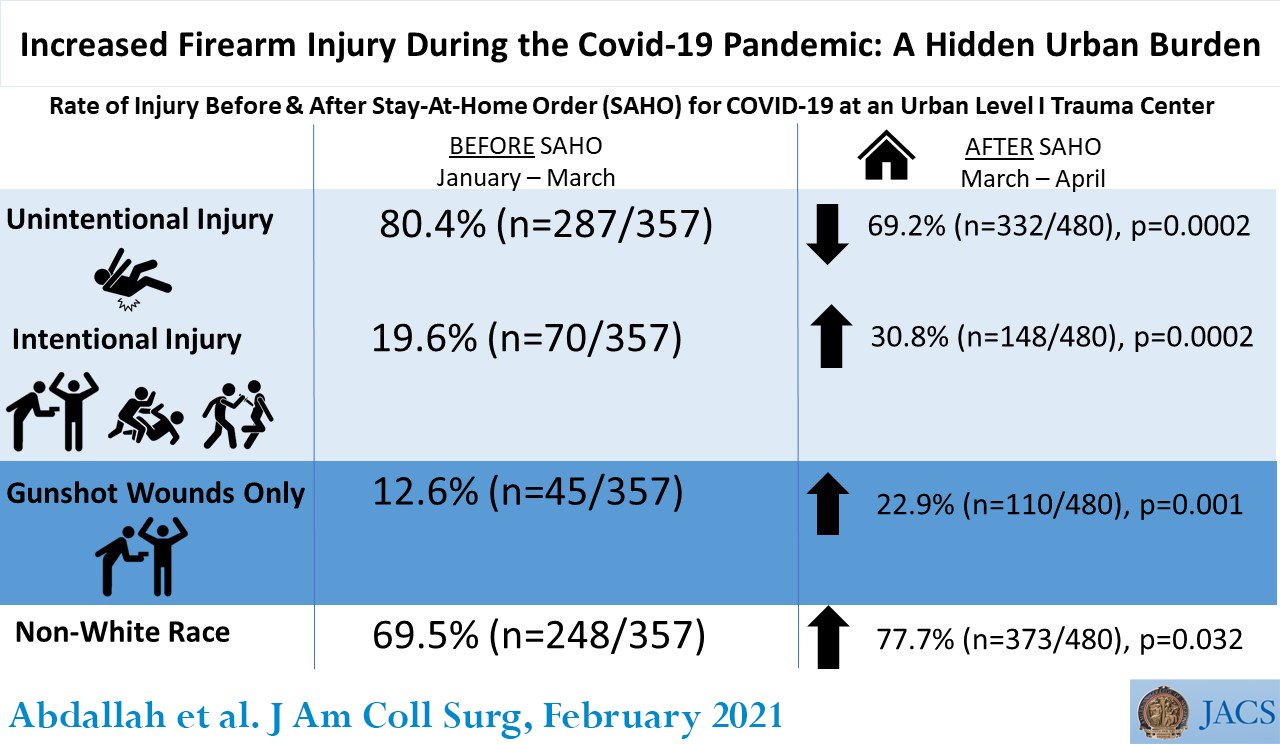Jose L. Pascual, MD, PhD, FACS, and colleagues at the University of Pennsylvania in Philadelphia report that while emergency department (ED) visits fell drastically during stay-at-home orders, visits for intentional injuries reached historic highs and have stayed there since.
As of October 19, Philadelphia has experienced 386 homicides, a 39 percent increase over the same time last year, reported KYW/AM Newsradio.
“We are now looking at the fact that even though main emergency department admissions have pretty much settled back to numbers pre-COVID—including trauma admissions, falls, motor-vehicle and motorcycle collisions, pedestrian accidents—and elective operations have mostly returned to normal, penetrating injury still remains high,” Dr. Pascual said. Importantly, he noted the same demographic—young African-American men—has been disproportionately impacted by these injuries, before as well as after statewide SAHO were eased.
The study evaluated trauma and emergency ED visits to the University of Pennsylvania Presbyterian Medical Center between February 1 and May 30, 2020, using the March 16 start of SAHO in Philadelphia as a demarcation of before and after periods. Penn Presbyterian is one of four adult level 1 trauma centers in Philadelphia and serves West Philadelphia and its western suburbs.
The analysis found significant differences in trauma trends in three key demographics between post- and pre-SAHO: a higher proportion of men presenting for trauma, with men accounting for 64.4 percent of cases before SAHO and 72.1 percent after (p=0.019); more younger patients presenting, with the mean patient age of 47.4 (range 22.1 years) before and 42.9 (range 20.3 years) after (p=0.009); and a higher proportion of non-white trauma patients, accounting for 69.5 percent before and 77.7 percent after (p=0.008). Specifically, the proportion of visits for gunshot wounds nearly doubled, from 12.6 to 22.9 percent (p<0.0001).
“The demographic that was most evidently involved here was the young black male, which is a demographic that was seen before in that violent injury category,” Dr. Pascual said. “Therefore it appeared that either the pandemic or the stay-at-home order, or both, may have had a direct result in augmenting the existing urban violent reality for that demographic.”
To get a more historical perspective on the impact of SAHO, Dr. Pascual and colleagues compared trauma injuries for the March 16 to May 30 period for 2016 through 2019. Up until March 16, trends of violent injuries were similar in 2020 to previous years, but Dr. Pascual noted, “After March 16, 2020, they were truly different, in that numbers for gunshot wounds increased by nearly 40 percent compared with the average of previous years.”
During the COVID-19 surge earlier this year, Penn Presbyterian implemented a host of recommendations to maintain its emergency department, including World Health Organization guidelines and the American College of Surgeons guidance statement on maintaining emergency care, released April 7. Before that, Dr. Pascual said they were relying on “hearsay” from physicians in Milan, the United Kingdom, and Hong Kong for COVID-patient-care early on in the pandemic.
“We had to make emergency decisions on how to put personal protective equipment (PPE) on the providers and how to separate the patients from each other in the trauma bay, which was as important when PPE was not readily available,” he said. The ACS statement helped in that regard. “Although I have to say,” Dr. Pascual added, “that the concurrent presence of both the pandemic and the endemic penetrating trauma did not get really defined or explained by any plan.”
The findings raise a host of questions about urban firearm violence as COVID-19 cases rise. Dr. Pascual notes, “How do we rid ourselves, as an urban center, as a trauma center, as a country of this very devastating change in trauma mechanism and in trauma distributions across a given demographic that is most at risk and most suffering from it? I’m very worried that this is not a story that is done. Although cases may rise in the weeks or months ahead, the numbers for COVID-19 and for trauma overall—pre- and post-COVID-19—have for at least a brief time settled, but the numbers for violent injury have not.”
Study coauthors are Hatem O. Abdallah, BS, and Cindy Zhao, BS, of the University of Pennsylvania Perelman School of Medicine; Elinore Kaufman, MD, Justin Hatchimonji, MD, and Robert A. Swendiman, MD, of the department of surgery at Perelman School of Medicine; and Lewis J. Kaplan, MD, Mark Seamon, MD, FACS., and William Schwab, MD, of the division of traumatology, surgical care, and emergency surgery at Penn Presbyterian Medical Center.
Dr. Pascual, an associate professor of surgery and a neurosurgery at the University of Pennsylvania Perelman School of Medicine, disclosed serving as a consultant to Pfizer and Grifols. He is a council member of the Society of Critical Care Medicine and chairs the Quality and Patient Safety Committee of the Eastern Association for the Surgery of Trauma.
“FACS” designates that a surgeon is a Fellow of the American College of Surgeons.
Citation: Increasing Firearm Injury During The Intense Period Of The Covid-19 Pandemic: A Hidden Urban Burden. Journal of American College of Surgeons, DOI: https://doi.org/10.1016/j.jamcollsurg.2020.09.028.
# # #
About the American College of Surgeons
The American College of Surgeons is a scientific and educational organization of surgeons that was founded in 1913 to raise the standards of surgical practice and improve the quality of care for all surgical patients. The College is dedicated to the ethical and competent practice of surgery. Its achievements have significantly influenced the course of scientific surgery in America and have established it as an important advocate for all surgical patients. The College has more than 82,000 members and is the largest organization of surgeons in the world. For more information, visit www.facs.org (.)


